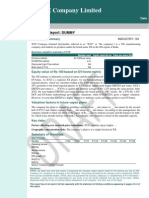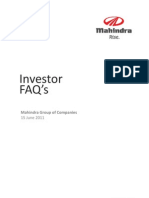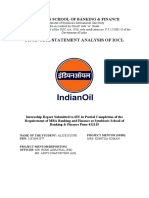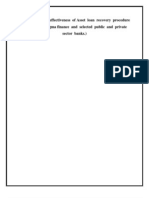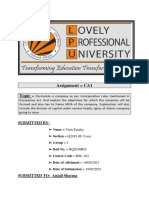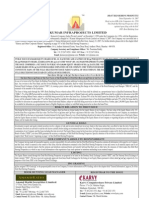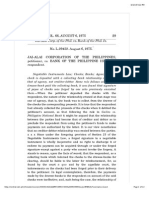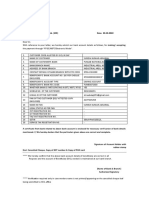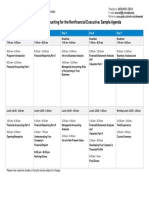Sample-Report-DCF As Per RBI Guidelines PDF
Sample-Report-DCF As Per RBI Guidelines PDF
Uploaded by
Rujan BajracharyaCopyright:
Available Formats
Sample-Report-DCF As Per RBI Guidelines PDF
Sample-Report-DCF As Per RBI Guidelines PDF
Uploaded by
Rujan BajracharyaOriginal Title
Copyright
Available Formats
Share this document
Did you find this document useful?
Is this content inappropriate?
Copyright:
Available Formats
Sample-Report-DCF As Per RBI Guidelines PDF
Sample-Report-DCF As Per RBI Guidelines PDF
Uploaded by
Rujan BajracharyaCopyright:
Available Formats
DCF Valuation Analysis
.......
---------------------------------------------------------------------------------------------------------
For.
Thankyou for Visting corporatevaluations.in and
downloading this report.
.. 2011
Strictly Private & Confidential
All rights reserved. Reprinted (or adapted) with
permission. Distribution of this material via the internet
does not constitute consent to the redistribution of it in
any other form or by any other person or entity. This
excerpted report, or any part thereof, may not be
reproduced or copied in any form or by any meansgraphic,electronic, or mechanical- without the prior
written permission of Corporate Professionals.
For any Professional Valuation advisory, feel free to
Contact:
Mr. Chander Sawhney
Asst. Vice President
M: +91 9810557353; Ph: 011-40622252
Email: chander@indiacp.com
Strictly Private and Confidential
Ref. No: CPC/MB/0/2010-11
SEBI Reg. No: INM000011435
The Board of Directors
.......
For the Kind attention of Mr,
Managing Director
Dear Sir,
Sub: Valuation Analysis of the equity shares of ....... as per DFCF Methodology
We refer to our engagement letter dated . 2011 for carrying out the Valuation of Equity Shares of ....... (here-in-after referred as
Company) as per Discounted Free Cash Flow(DFCF) methodology. In accordance with the terms of the engagement, we are
enclosing our report along with this letter. In attached report, we have summarized our Valuation Analysis of the Company as at July
.. 2011 together with the description of methodologies used and limitation on our Scope of Work. This Valuation Analysis is
confidential and has been prepared exclusively for the Management of Company. It should not be used, reproduced or circulated to any
other person, in whole or in part, without the prior consent of Corporate Professionals Capital Private Limited. Such consent will only be
given after full consideration of the circumstance at the time. We are aware that the conclusion in this report may be used for the
purpose of certain statutory disclosure by Company and we provide consent for the same.
Trust the above meets your requirements.
Please feel free to contact us in case you require any additional information or clarifications.
Yours Faithfully,
For Corporate Professionals Capital Private Limited
.
[Authorized Signatory]
Strictly Private and Confidential
Contents
Executive Summary
Purpose of Valuation
Industry Assessment
Company Assessment
12
Valuation Methodology, Approach and Analysis
17
Caveats
21
Annexure : Projected Financials
22
Strictly Private and Confidential
EXECUTIVE SUMMARY
....... is a company incorporated under the provisions of Indian Companies Act, 1956 and is one of the leading Indian companies in the
field of .. The Company is engaged in manufacturing ... The Company has been accredited by
ISO/TS .certification.
The Company is a Joint Venture with M/s ..of .. (here-in-after referred as Foreign Company), one of the leading .. in
the field of design, manufacturing and marketing of ..for the automotive industry. We have been informed that the foreign
company is presently having . shareholding in the Company and it has been agreed between the Companies to raise the
shareholding of the foreign company upto .
In this respect, we as a Merchant Banker have been appointed by the Company to determine the fair value of its equity shares in
accordance with the pricing norms of the Reserve Bank of India (RBI) to ascertain the minimum price at which the equity shares of
Company can be issued and allotted to the foreign Company as per the applicable pricing methodology i.e. Discounted Free Cash
Flow.
It is pertinent to mention that the valuation of a business is not an exact science and ultimately depends upon a number of factors like
the past financials, expected financial results, industry scenario, market recognition etc. Though there are multiple valuation
methodologies, however in accordance with the requirement of the RBI Law as detailed later in this report, we have carried out this
Valuation Analysis of Company based upon Discounted Free Cash Flow Methodology.
Based on our Analysis of the Company and subject to our caveats as further detailed in this report, the fair value of equity
shares of the Company may be taken at ` .. Lacs and the value per Equity share having face value of ` .each
may be taken as `.. each.
Strictly Private and Confidential
PURPOSE OF VALUATION
ABOUT THE TRANSACTION
Based on the discussions held with the Management of the Company, we understand that the Company is a Joint Venture with M/s
..n (here-in-after referred as Foreign Company), one of the leading .. in the field of design, manufacturing and
marketing of .. products for the automotive industry. We have further been told that the foreign company is presently having ..
shareholding in the Company and it has been agreed between the Companies to raise the shareholding of the foreign company upto
..%.
In view of above management needs to ascertain the minimum value of Company at which the Equity Shares may be issued and
allotted to foreign Company in accordance with Foreign Exchange Management (Transfer or Issue of Security by Person Resident
Outside India) Regulations, 2000 notified vide Notification No.: FEMA 20/2000- RB dated May 3, 2000, as amended from time to time.
Notification No. FEMA 205/2010-RB dated 07.04.2010 effective from 21st April, 2010 has provided that where the shares of an Indian
company are not listed on any recognized stock exchange in India, the price of shares issued to foreign Company shall not be less than
the fair valuation of shares done by a SEBI Registered Category I Merchant Banker or a Chartered Accountant as per the Discounted
Free Cash Flow Method (DFCF).
In this respect, we as a Merchant Banker have been appointed by the Company to determine the minimum value of its equity shares in
accordance with the pricing norms of the Reserve Bank of India (RBI) over and above which the equity shares of Company can be
issued and allotted to the foreign Company.
Strictly Private and Confidential
SCOPE OF SERVICES
This valuation report has been prepared by M/s Corporate Professionals Capital Private Limited, SEBI Registered Category I,
Merchant Banker to determine the fair value of equity shares of Company in accordance with the Discounted Free Cash Flow
Methodology.
SCOPE LIMITATION
This valuation report has been prepared on the basis of the Certified Projected Financials of the company for the next five financial
years ended March 2015 duly supplemented by its Terminal Value at end of Five Years, along with discussion held with the
management and other publically available information.
The valuation exercise was carried out under the following limitations:
The Valuation analysis of equity shares is based upon the future projections of company provided to us, which is based upon
various assumptions made by Company relating to the operations of its business and any change in these assumptions may have
an impact on the conclusion of this report.
We have not made an appraisal or independent valuation of any of the assets or liabilities of the Company and have not
conducted an audit or due diligence or reviewed/validated the financial data provided by the management.
The scope of our work has been limited both in terms of the areas of the business and operations which we have reviewed and
the extent to which we have reviewed them. There may be matters, other than those noted in this Report, which might be relevant
in the context of the transaction and which a wider scope might uncover.
Strictly Private and Confidential
INDUSTRY ASSESSMENT
GROWTH TREND OF AUTOMOTIVE INDUSTRY
1. Spectacular Growth between FY 2003 and FY 2007
The Indian Commercial Vehicle (CV) Industry witnessed Spectacular Growth between FY 2003 and FY 2007, growing at CAGR of
more than 25%. A favorable macroeconomic environment, increased industrial activity and easy financing, among other reasons,
were significant drivers of growth in domestic market.
2. Growth slowed in FY 2008 and fell in FY 2009
A Corrective period followed the five year phase that witnessed growth of more than 25%. In FY 2008 easy financing, which was a
significant growth driver, declined significantly. The interest rate began to increase, thereby impacting borrowing cost and
subsequently the total cost of ownership. With as many as 90 out of 100 vehicles being sold on finance, the liquidity crunch came as
a big blow.
The Global slowdown adversely impacted both global and domestic demand in FY 2009. Industrial activity plummeted, and GDP
Growth projections were reduced with every subsequent revision. The third quarter of FY 2009 saw the worst for the Indian
automotive Industry in recent times, with CV sales falling by 48% in domestic market. Export also slumped by 40% in the same
period.
3. A Rebound in FY 2010
Increased industrial activity in the FY 2010 along with various government benefits provided to boost sales and have yielded positive
sales. The Industry has experienced spectacular growth across all segments at an overall growth rate of 26%.
Strictly Private and Confidential
4. Industry Future Outlook
Currently, India has lowest MHCV penetration among the BRIC economies and higher than average paved road penetration. Both
the reflective of the significant opportunity share for the CV industry in India. However, there are a fewer no. of expressways in India
as compared to its peers. This will have to be increased to boost CV industry growth.
Growth in Industrial activity and increasing road penetration are likely to lead to increased CV sales, which
are forecasted to reach 1 million units by 2020
(Source: ICRA Industry outlook)
Strictly Private and Confidential
IMPACT ON AUTO ANCILLARY INDUSTRY
On similar lines, after witnessing strong pace of growth for many years, India's auto ancillary industry also faced a serious demand
crunch in the FY 2009. Besides sharp decline in demand, the industry faced whole range of other issues including fluctuations in foreign
exchange rates, and the drying up of liquidity in the market.
However, even as global auto industry was still facing difficulties, Indian auto makers started changing gears with the start of FY2010.
Riding on stimulus measures taken by the government, the original equipment manufacturers (OEMs) witnessed improvement in
demand conditions and auto sales increased steadily in first half of FY2010. The second half has been even more bullish and most of
the auto companies have hit their record ever sales or production numbers in last couple of months. This has resulted in significant
improvement in demand side for auto part makers as well in FY2010. In fact, last few months have been so bullish for the auto industry
that the ancillary industry has nearly run out of capacity in case of many parts.
Demand Side Improves
Growth Trend of Auto Ancillary Industry
Auto component makers have seen significant improvement in demand in the FY 2010
after facing serious depression in second half of 2008-09. The improvement has been
owing to strong auto sales riding on stimulus measures taken by the government.
Baring the medium and heavy commercial vehicle segment, all other segments started
performing right from start for the fiscal and the upward trend only gathered the
momentum month-after month. Even the commercial vehicle segment started
performing in the second half of the 2009-10 while passenger cars and two-wheelers
saw record sales as economic outlook improved and deferred demand retuned into the
market.
Strictly Private and Confidential
SITUATION OF EXPORTS AND IMPORTS OF AUTO ANCILLARIES
Exports Remain Under Pressure
Exports constitute a key source of revenue for the Indian automotive component industry. However, right from the start of global
economic downturn, demand from the key areas like the US and EU declined sharply. Sharp contraction witnessed in the automotive
sales in these two regions, which accounts for over 65% of India's total auto part exports, was bound to have adverse impact on
component makers.
However, while there have been considerable improvements in the domestic demand conditions, exports of auto components continue
to remain under pressure despite improvement in sales seen in recent months in both the US and EU. In the first half of current fiscal,
market size of cars and light trucks contracted by 35% while the same in Europe went down by 23%. While growth has returned in both
the places in auto sales in second half, overall figure for FY2010 is expected to remain 12-14% down on y/y basis, which will also lead
to a contraction in total exports of auto parts to these regions. In the next year exports demand will start growing again, but possible
gains will be capped by potential appreciation in the Indian currency going forward.
Surging Imports a Medium Term Challenge
A major threat being faced by the Indian automotive component industry is surging imports. Indian government has been lowering the
import duty on various auto parts in line with its commitments at bilateral and multilateral trade agreements. This however has resulted
in a surge in imports, particularly from China. From about ` 30 crore in 2000, imports of Chinese made auto parts has increased to over
` 2,500 crore in 2009. Chinese products now account for 10% of the total Indian auto components market compared with just 1% in
2000.
Strictly Private and Confidential
According to the Automotive Component Manufacturers Association of India
(ACMA), imports of components from China had registered a 97% compounded
annual growth rate over the past seven years. Chinese producers enjoy a number
of advantages, the biggest of them being lower wage bill and cheaper cost of steel
and power.
While the Chinese products often fail to match the quality of their Indian
counterparts, particularly in the precision parts segment, the cost advantage
enjoyed by the Chinese is likely to hurt the Indian companies if the current trend
continues. In fact the industry has been urging the government for an import duty
on Chinese components but there has been no final decision on the issue yet.
FUTURE OUTLOOK
India's auto ancillary industry is once again on growth path. After facing a difficult period in last fiscal, things have been improving in the
current year and both the OEM and replacements segments are witnessing strong demand. Going forward, as the Indian auto
sector grows, the auto ancillary sector will expand. The industry is also graduating towards the world-class technology. India is
becoming the global manufacturing hub for the small cars and the trend will certainly help boost the prospects of auto part makers.
The major issue for the industry is from export side. Export sales have been on an average around 19-20% of revenue to the auto part
industry as a whole. However, the segment witnessed contraction last year and growth is not likely to be significant this year either.
However, increased local demand and also increasing auto exports from India itself should help the industry address
slowdown in export demand for auto components.
10
Strictly Private and Confidential
Increase in imports can be another challenge. Manufacturers however point out that Chinese engineering in auto parts, particularly in
precision equipment will not be able match Indian due to long experience of Indian auto ancillary players in this segment. However, the
pace of increase in imports is alarming and therefore the government may have to step in at some stage to provide a level playing field
to domestic layers.
Overall, the auto ancillary industry is now in a recovery mode. Strong demand from the OEM segment and continued expansion of the
replacement demand will provide reasonable revenue visibility going forward. Although the export segment will continue to underperform, this will be partly compensated with India becoming a hub for manufacturing for small cars and resulting increase in demand
from export oriented production within the country.
Year 2010 is definitely poised to be a better year for the Industry as the automotive sales volumes for the First Quarter of FY 2011
indicate. Owing to Indias low cost production capabilities, several international players have already announced their plans to
manufacture small cars in India.
(Source: Ace Equity Industry Research)
11
Strictly Private and Confidential
COMPANY ASSESSMENT
.......
BASIC INFORMATION:
The Company was incorporated on under the name and style of , thereafter on it was converted into a
Public Limited Company and on the name of the Company was changed to ........ The Registered Office of the Company is
situated at ..
The company is one of the leading Indian companies in the field of manufacturing and marketing and manufacturing of equipments for
the .automotive industry. It is engaged in manufacturing for automobiles industries and Industrial
hoses. The Company has been accredited by ISO/TS 1certification.
Orginally
the
manufacturing
Unit
of
the
Company
was
set
up
at
...
.
The Company is a Joint Venture with
strength.
M/s .. (here-in-after referred as Foreign Company), one of the leading
..companies in the field of design, manufacturing and marketing of sealing products for the automotive industry. We have been
informed that the foreign company is presently having ..shareholding in the Company and it has been agreed between the
Companies to raise the shareholding of the foreign company upto With this, both the Companies intend to have access to each
others competitive strengths and the Company would get access to the passenger vehicle segment of the Auto Industry.
12
Strictly Private and Confidential
CAPITAL STRUCTURE
The Capital Structure of the Company as on 31st March, 2010 is as under:
Amount in (` Millions)
Provisional
31.03.2010
Particulars
AUTHORIZED
ISSUED SUBSCRIBED & PAID UP
.
HISTORICAL CONSOLIDATED INCOME STATEMENT:
Amount in (` Millions)
Provisional
For the Period Ended
31.3.2010
EBITD
Finance cost
Depreciation
Profit Before Tax
Provision For Taxes
Profit After Tax
13
Audited
31.3.2009
31.3.2008
Strictly Private and Confidential
HISTORICAL CONSOLIDATED BALANCE SHEET:
Amount in (` Millions)
Provisional
Audited
Particulars
31.3.2010
Sources of Funds
Share Capital
Reserve and Surplus Account
Secured Loans
Unsecured Loans
Total
Application of Funds
Net Fixed Assets
Net Current Assets
Miscellaneous Expenditure
Profit and Loss Account
Total
14
31.3.2009
31.3.2008
Strictly Private and Confidential
PROJECTED BUSINESS PLAN SNAPSHOT
Based on the discussion held with the management of the company and documents provided to us, we understand the future business
plan has following key features:
1.
Presently the company is catering its product only in.
2.
The Company is additionally targeting the .. in future.
3.
Based upon future outlook of Auto Industry, Business in the .. is expected to grow phenomenally subject to quality,
price and deliveries.
4.
The plan involves serving to the big players of auto industry including etc. in India. The company has
prepared a list of are scheduled to be launched in India within the next two years
5.
The Joint Venture partner .. would provide necessary technical assistance to the Company.
6.
The plan involves a capex of Rs. ..lacs. This amount would be infused as Equity Capital by the Foreign partner.
15
Strictly Private and Confidential
VALUATION METHODOLOGY, APPROACH AND ANALYSIS
Notification No FEMA 205/2010-RB dated 07.04.2010 effective from 21st April, 2010 has provided that where the shares of an Indian
company are not listed on any recognized stock exchange in India, the price of shares issued to foreign Company shall not be less than
the fair valuation of shares done by a SEBI Registered Category I Merchant Banker or a Chartered Accountant as per the Discounted
Free Cash Flow Method.
Therefore, this Valuation Analysis report is thus valuing the equity shares of the Company specifically as per the Discounted Free Cash
Flow Methodology (DFCF) only.
BASIS OF DISCOUNTED FREE CASH FLOW METHOD (DFCF):
The DFCF to equity method expresses the present value of the business attributable to equity shareholders as a function of its future
cash earnings capacity. This methodology works on the premise that the value of a business is measured in terms of future cash flow
streams, discounted to the present time at an appropriate discount rate. The value of the equity is arrived at by estimating the Free
Cash Flows (FCF) to equity and discounting the same at the cost of equity (Ke). The DFCF method using the FCF, values the benefits
that accrue to the equity shareholders of the Company. This is estimated by forecasting the free cash flows available for the company
(which are derived on the basis of likely future earnings of the companies) and discounting these cash flows to their present value at the
Ke. The DFCF methodology is considered to be the most appropriate basis for determining the earning capability of a business. It
expresses the value of a business as a function of expected future cash earnings in present value terms. The approach seeks to
measure the intrinsic ability of the business to generate cash attributable to its equity shareholders.
16
Strictly Private and Confidential
In the DFCF approach, the appraiser estimates the cash flows of any business after all operating expenses, taxes, and necessary
investments in working capital and Capex is being met. Valuing equity using the free cash flow to stockholders requires estimating only
free cash flow to equity holders, after debt holders have been paid off. As this methodology is focused at Equity Shareholders so the
interest and finance charges are also deducted.
The following box provides generalized steps for using discounted cash flows to estimate the value of the equity position of a
company
STEPS FOR FINDING FCF TO VALUE EQUITY SHARES
=
+
Profit before tax
Taxes
Profit after tax
Non-cash costs
Capital expenditures
Increase in NCWC
Changes in Debts
Terminal Value
=
=
Free Cash Flow
DFCF
Step 1:Arrive at Profit Before Tax
Step 2: Less tax.
Step 3: Add back non-cash costs (already subtracted in step 1).
Step 4: Subtract capital expenditures.
Step 5: Subtract Increases in non cash working capital.
Step 6: Take into account the effect of changes in Debts.
Step 7: Add the terminal value accruing to equity holders in the final year.
Step 8: Discount the FCF for each year at the cost of equity.
For the purpose of valuation of equity shares in this transaction through DFCF methodology, we have relied upon the projections
provided by the management for the five financial years ending March 31st . duly supplemented by its Terminal Value
based on the Gordon Model along with the discussions held with the management and extrapolating the free cash flows at an annual
growth rate of . percent to perpetuity. The Cost of Equity has been determined at .. per cent as per CAPM model.
17
Strictly Private and Confidential
Amount in (` Millions)
.......
VALUATION AS PER DISCOUNTED FREE CASH FLOW METHODOLOGY
YEAR
2010-11
2011-12
2012-13
2013-14
2014-15
PARTICULARS
Projected
Projected
Projected
Projected
Projected
Operating PBT
Less: Direct Taxes Paid
PAT
Add : Depreciation
Less :Capital Expenditure
Less : Change in Non Cash Working
Capital
Add : Increase/(Decrease) in Debts
Free Cash Flows (Rs.)
Discounting Factor
Discounted Present Value of Cash
flows
Discounted Present Value of Equity
Shares
Expanded Number of Equity Shares
Present Number of Equity Shares
Equity Value Per Share at Expanded
Capital
Equity Value Per Share at Present
Capital
18
Perpetuity
Strictly Private and Confidential
Projected Balance Sheet and Profit & Loss account for the next five financial years ended March 31st, as certified by the
management is attached as Annexure to this report.
Projected Non operative Income and Expenses have been ignored by us in this Valuation.
Based on our Analysis of the Company and subject to our caveats as further detailed in this report, the fair value of equity
shares of the Company may be taken at ` . Lacs and the value per Equity share (after taking the proposed allotment
into account) having face value of Rs. 10 each may be taken as `.. each.
19
Strictly Private and Confidential
CAVEATS
This Valuation Report has been issued on the specific request of ....... to ascertain the minimum value at which the equity shares
of Company should be issued and allotted to the foreign Company as per the Discounted Free Cash Flow Methodology. This
Report is prepared exclusively for the above stated purpose and must not be copied, disclosed or circulated or referred to in
correspondence or discussion with any other party. Neither this report nor its content may be used for any other purpose without
prior written consent of M/s Corporate Professionals Capital Private Limited.
We have summarized the Valuation Analysis of the equity shares of the Company based on the information as was provided to us
pursuant to the meetings held with the management of Company and other publically available information. We do not assume
any responsibility for the accuracy or reliability of such documents on which we have relied upon in forming our opinion.
Although every effort has been made by us to verify and corroborate each document and to ensure that no inaccurate or
misleading data, information, statement or opinion appears in this document, we wish to make it clear that the information and
data appearing herein are the responsibility of the contributors. Accordingly, we do not accept any responsibility whatsoever for
the consequences of any such inaccurate or misleading information or data, opinion or statement.
We have no present or planned future interest in ....... and the fee for this Valuation analysis is not contingent upon the values
reported herein.
The Valuation Analysis contained herein is not intended to represent the value at any time other than the date that is specifically
stated in this Report. This Report is issued on the understanding that the Management of ....... has drawn our attention to all
matters of which they are aware, which may have an impact on our report up to the date of signature. We have no responsibility
to update this report for events and circumstances occurring after the date of this Report.
20
Strictly Private and Confidential
ANNEXURE : PROJECTED FINANCIALS
PROJECTED BALANCE SHEET:
Amount in (` Millions)
Particulars
2010-11
2011-12
2012-13
Projected
Liabilities
Equity Share Capital
Reserves & Surplus
Total Term Liabilities
Total
Assets
Gross Block
Accumulated Depreciation
Net Block
Net Current Assets(excluding cash and cash
equivalents)
Cash and cash equivalents
Preliminary expenses not w/off
Total
21
2013-14
2014-15
Strictly Private and Confidential
PROJECTED PROFIT AND LOSS STATEMENT
Amount in (` Millions)
Particulars
2010-11
2011-12
2012-13
Projected
Net Sales
Cost of Sales
Raw materials(including stores & spares
and other items used in the process of
(i)
manufacture
(a) Imported
(b) Indigenous
(ii)
Other Spares
(a) Imported
(b) Indigenous
(iii) Power & Fuel
(iv) Direct Labour (Factory wages & salary )
(v)
Other manufacturing expenses
(vi) Depreciation
Sub - Total ( i to vi )
(vii) Add : Opening stocks - in - process
(viii) Deduct : Closing stick - in - process
(ix) Cost of Production
(x)
Add : Opening stock of Finished goods
(xi) Deduct : Closing stock of finished goods
(xii) Sub - Total ( Total cost of Sales )
Gross Profit
Selling , General and Administrative
Expenses
Sub - Total
Operating Profit before interest
22
2013-14
2014-15
Strictly Private and Confidential
Interest & Financial Charges
Operating Profit after interest
(I)
(ii)
(iii)
Add other non - operative income
(a) Bank Interest
(b) Miscellaneous
(c) Liabilities written back
Sub - Total ( Income )
Deduct Other non - operative expenses
(a) Prem. Expenses written off
(b) Expenses pertaining to earlier years
deferred revenue
Sub - Total ( Expenses )
Net of other non - operating Income / Expenses
Profit before Tax / Loss
Provision for Taxes
Profit after Taxes
23
Strictly Private and Confidential
About www.CorporateValuations.in
is a venture promoted by Corporate Professionals Capital Pvt. Ltd, SEBI Registered (Cat-I)
Merchant Banker. By virtue of our Dedicated Valuation Team , Inhouse Research Wing and proven expertise in Corporate Taxation Advisory,
we have attained leading edge, technical knowledge and indepth industry experience that allow us to provide Independent Valuation & Fairness
Opinion across different context, Industries and Boundaries.
Our Valuation Offerings
-
Business Valuation;
Acquisition and Investment Valuation
Valuation of shares as per Discounted Free Cash Flow Method
Court Approved Merger & Demerger Valuation and Swap Ratio
M & A Fairness Opinion
ESOP Valuation
Tax Valuation
Valuation of Business Segments for Spin-off & Restructuring
FOREX & Overseas Transactions Valuation
Intangibles Valuation/Valuation for Regulatory Reporting
Build/Review Financial Models
24
Strictly Private and Confidential
Corporate Professionals Capital Pvt. Ltd.
SEBI Registered Category I Merchant Banker
D-28, South Extension I, New Delhi-110 049
Mr. Maneesh Srivastava (Manager)
M: +91 9871026040; Ph: 011-40622255; Fax:011-40622201
E: info@corporatevaluations.in
Web: www.corporateprofessionals.com
www.corporatevaluations.in
DisclaimerThis publication contains information in summary form and is therefore intended for general guidance only. It is not intended to be a
substitute for detailed research or the exercise of professional judgment. Neither corporatevaluations.in nor any other member of the
Corporate Professionals organization accept any responsibility for loss occasioned to any person acting or refraining from action as a result
of any material in this publication. On any specific matter, reference should be made to the appropriate advisor.
Our Services: Public Issue Management Private Placements Corporate Debt Funding Mergers & Acquisitions Business
Valuations ESOP/ESPS Transaction Advisory Cross Border Restructuring
2011, Corporate Professionals. All rights reserved
25
You might also like
- Budget Rent A Car - StrategyDocument15 pagesBudget Rent A Car - Strategydevam chandra100% (1)
- GLCA DA MS Excel HBFC Project Modified-1Document3 pagesGLCA DA MS Excel HBFC Project Modified-1Subhan Ahmad KhanNo ratings yet
- PSO Report by Mansoor Ali Seelro (Strategic Management)Document26 pagesPSO Report by Mansoor Ali Seelro (Strategic Management)AL-HAMD GROUP100% (3)
- Training ModelDocument1,357 pagesTraining ModelRujan Bajracharya33% (3)
- Lease Financing PDFDocument31 pagesLease Financing PDFreshma100% (5)
- A Sum Up The Present Values of The Hernandezes AssetsDocument1 pageA Sum Up The Present Values of The Hernandezes AssetsAmit PandeyNo ratings yet
- New Account Opening Form Individual UpdateDocument10 pagesNew Account Opening Form Individual UpdateAhmedinNo ratings yet
- Sample Report DCFDocument0 pagesSample Report DCFagarwalandyNo ratings yet
- Sample ESOP ReportDocument18 pagesSample ESOP Reportsathish_bilagiNo ratings yet
- Comparing and Analysis Financial Statement of Automobile Sector BYDocument110 pagesComparing and Analysis Financial Statement of Automobile Sector BYSamina MominNo ratings yet
- DCF Valuation AnalysisDocument19 pagesDCF Valuation AnalysisdeepaNo ratings yet
- Study of Annual Report of Maruti Suzuki India LimitedDocument10 pagesStudy of Annual Report of Maruti Suzuki India LimitedAmay KutariyarNo ratings yet
- Business Beats -December EditionDocument10 pagesBusiness Beats -December Editionabhay.kl9965No ratings yet
- Baker Tilly Report PriceDocument25 pagesBaker Tilly Report PriceHafiz Saddique MalikNo ratings yet
- DCF Valuation AnalysisDocument19 pagesDCF Valuation Analysisteresa baldozaNo ratings yet
- Project Report ON: Portfolio Management in Karvy Stock Broking LimitedDocument6 pagesProject Report ON: Portfolio Management in Karvy Stock Broking LimitedABHIGAURAVPROJECTNo ratings yet
- Term Paper AciDocument56 pagesTerm Paper AciNazibur RahmanNo ratings yet
- Doing Business in IndiaDocument19 pagesDoing Business in IndiaAparna SinghNo ratings yet
- Audit To An Enterprise Is An Important As Oxygen For Human BeingDocument28 pagesAudit To An Enterprise Is An Important As Oxygen For Human BeingCA. (Dr.) Rajkumar Satyanarayan AdukiaNo ratings yet
- Upd ReprtDocument51 pagesUpd ReprtPankaj MadaanNo ratings yet
- Internal Assessment Based On Summer Internship Company (Praedico Global Research Private Limited)Document3 pagesInternal Assessment Based On Summer Internship Company (Praedico Global Research Private Limited)Nishant BhartiNo ratings yet
- 4202 Update RemovedDocument31 pages4202 Update RemovedMahmoda MobarakNo ratings yet
- General Electric - Finance - Task - SolutionDocument11 pagesGeneral Electric - Finance - Task - SolutionJehanzaibNo ratings yet
- A Project Report: "Ipo of Varahi Limited"Document22 pagesA Project Report: "Ipo of Varahi Limited"Vishavdeep Singh SidhuNo ratings yet
- Sample Valuation ReportDocument17 pagesSample Valuation ReportabhidadNo ratings yet
- Deepesh Agarwal - Financial Statement Analysis of Tata Motors LTDDocument72 pagesDeepesh Agarwal - Financial Statement Analysis of Tata Motors LTDBhanu Prakash100% (1)
- avanse-financial-notice-to-investorsDocument2 pagesavanse-financial-notice-to-investorsVinay PrakashNo ratings yet
- MandM Investor FAQsDocument11 pagesMandM Investor FAQsGaurav BiswasNo ratings yet
- Business Analysis ReportDocument23 pagesBusiness Analysis ReportDulon DuttaNo ratings yet
- Honda: The Power of DreamsDocument7 pagesHonda: The Power of DreamsWajahat AliNo ratings yet
- GKC Projects Limited: Enterprise Valuation ReportDocument31 pagesGKC Projects Limited: Enterprise Valuation Reportcrmc999No ratings yet
- Internship Report - 03 June 22Document12 pagesInternship Report - 03 June 22Alina KujurNo ratings yet
- What Is Income StatementDocument31 pagesWhat Is Income StatementTakibul HasanNo ratings yet
- Sfad Final Project LMS-1Document13 pagesSfad Final Project LMS-1Mansoor ArshadNo ratings yet
- Ubi Credit Asked QuesDocument5 pagesUbi Credit Asked QuesRahul RajNo ratings yet
- Loan RecoveryDocument62 pagesLoan RecoveryKaran Thakur100% (1)
- Mahindra Annual Report SummaryDocument3 pagesMahindra Annual Report Summaryvishakha AGRAWALNo ratings yet
- Auditors Report of Insurance Company & Typical Audit ProgrammesDocument26 pagesAuditors Report of Insurance Company & Typical Audit ProgrammesShakib Ahammed ChowdhuryNo ratings yet
- Ready Made R HP FinalDocument314 pagesReady Made R HP FinalJnanamNo ratings yet
- Analysis of Stock MarketDocument19 pagesAnalysis of Stock MarketNibin Varghese CharleyNo ratings yet
- Investment AnalysisDocument31 pagesInvestment AnalysisFarzana Fariha LimaNo ratings yet
- VguardDocument313 pagesVguardSreekanth SreekumarNo ratings yet
- Sarfraz FM ToyotaDocument25 pagesSarfraz FM Toyotamsamib4uNo ratings yet
- Bhavya N S 2ND MbaDocument86 pagesBhavya N S 2ND MbaChiduNo ratings yet
- BSL102 - CA1 PriyanshuDocument10 pagesBSL102 - CA1 PriyanshuAman KumarNo ratings yet
- JkumarDocument250 pagesJkumar80ALLAVINo ratings yet
- Foundations of BankingDocument11 pagesFoundations of BankingMichela CutajarNo ratings yet
- Final Project Report On Au Fin. JaipurDocument71 pagesFinal Project Report On Au Fin. Jaipurkapiljjn100% (1)
- Quarterly Report Q2 10Document43 pagesQuarterly Report Q2 10Abhishek SainiNo ratings yet
- Case Study - Valuation Report On: IRB Infrastructure LimitedDocument59 pagesCase Study - Valuation Report On: IRB Infrastructure LimitedManjunath S MuddarajNo ratings yet
- Individual Assignment: Analysis of Audit Reports of Premier Bank LimitedDocument7 pagesIndividual Assignment: Analysis of Audit Reports of Premier Bank LimitedSohel MahmudNo ratings yet
- Final Valuation ReportDocument11 pagesFinal Valuation Reportzaffer belgaumNo ratings yet
- CF Assignment 1 Oct21 To Jan 22 BatchDocument9 pagesCF Assignment 1 Oct21 To Jan 22 BatchShikha NairNo ratings yet
- Study of Fundamental AnalysisDocument15 pagesStudy of Fundamental AnalysisDhananjay KumarNo ratings yet
- Hinduja Leyland Finance LTDDocument42 pagesHinduja Leyland Finance LTDparamjeet99100% (6)
- Working Capital and Fund Flow Statement of Modest Infrastucture LTDDocument27 pagesWorking Capital and Fund Flow Statement of Modest Infrastucture LTDMegha HumbalNo ratings yet
- Fundamanetal Analysis of Automobile Industry (Tata Motors)Document63 pagesFundamanetal Analysis of Automobile Industry (Tata Motors)Amit Sharma100% (1)
- IIP REPORT On Fundamental Analysis On Indian Steel IndustryDocument60 pagesIIP REPORT On Fundamental Analysis On Indian Steel IndustryKishori Asawa100% (1)
- 2 SM Tariq Zafar 36 Research Article BMAEBM September 2012Document10 pages2 SM Tariq Zafar 36 Research Article BMAEBM September 2012muktisolia17No ratings yet
- Exide Pakistan LTD Swot Analysis BacDocument13 pagesExide Pakistan LTD Swot Analysis BacJawad AhmadNo ratings yet
- Capital Market Operation: Submitted By: Submitted ToDocument8 pagesCapital Market Operation: Submitted By: Submitted ToSatyam SharmaNo ratings yet
- Business Plan TemplateDocument19 pagesBusiness Plan TemplatebiffinNo ratings yet
- Financial Report Analysis: Date of Submission CDocument18 pagesFinancial Report Analysis: Date of Submission CVikraman SridharNo ratings yet
- Business Credit Institutions Miscellaneous Revenues World Summary: Market Values & Financials by CountryFrom EverandBusiness Credit Institutions Miscellaneous Revenues World Summary: Market Values & Financials by CountryNo ratings yet
- © The Institute of Chartered Accountants of IndiaDocument4 pages© The Institute of Chartered Accountants of IndiaRujan BajracharyaNo ratings yet
- © The Institute of Chartered Accountants of IndiaDocument4 pages© The Institute of Chartered Accountants of IndiaRujan BajracharyaNo ratings yet
- Bos 16383Document4 pagesBos 16383Rujan BajracharyaNo ratings yet
- © The Institute of Chartered Accountants of IndiaDocument4 pages© The Institute of Chartered Accountants of IndiaRujan BajracharyaNo ratings yet
- As Group 2Document64 pagesAs Group 2Rujan BajracharyaNo ratings yet
- CeCOC LowDocument8 pagesCeCOC LowRujan BajracharyaNo ratings yet
- E-Arşiv Fatura: Page 1 / 1Document1 pageE-Arşiv Fatura: Page 1 / 1Nurcan AğazadəNo ratings yet
- As 12Document17 pagesAs 12akshat beriwalaNo ratings yet
- Direct Deposit / Automatic Payment Information FormDocument1 pageDirect Deposit / Automatic Payment Information FormMARC ANDREWS WOLFFNo ratings yet
- Social Security System: Collection List Summary For The Month of September 2018Document2 pagesSocial Security System: Collection List Summary For The Month of September 2018Car ResNo ratings yet
- 06 Jai-Alai V BPIDocument12 pages06 Jai-Alai V BPIRaymond ChengNo ratings yet
- New Bank Mandate Form 2-1Document1 pageNew Bank Mandate Form 2-1Yug JainNo ratings yet
- Financial-Analysis-Procter&Gamble-vs-Reckitt BenckiserDocument5 pagesFinancial-Analysis-Procter&Gamble-vs-Reckitt BenckiserPatOcampoNo ratings yet
- Kotak Mahindra BankDocument9 pagesKotak Mahindra BankPrajwal KaDwad100% (1)
- Risk Is Where You'Re Not LookingDocument20 pagesRisk Is Where You'Re Not LookingJesse100% (5)
- CBCS SyllabusDocument34 pagesCBCS SyllabusMotiurNo ratings yet
- Demystifying Mutual Funds - 30june2017Document22 pagesDemystifying Mutual Funds - 30june2017Naveen RaajNo ratings yet
- Expanded Withholding TaxDocument6 pagesExpanded Withholding TaxFernando II SuguiNo ratings yet
- Chapter I - Form & Interpretation SECTION 1. Form of Negotiable Instruments - An Instrument To BeDocument22 pagesChapter I - Form & Interpretation SECTION 1. Form of Negotiable Instruments - An Instrument To BeCL DelabahanNo ratings yet
- Varun Nagar Cooperative Society: (Document Subtitle)Document9 pagesVarun Nagar Cooperative Society: (Document Subtitle)Vedansh DubeyNo ratings yet
- Invesment Center & Transfer PricingDocument8 pagesInvesment Center & Transfer Pricingandi fauziah amaliahNo ratings yet
- Meiditya Larasati - 01017190019 - PR Pertemuan 03Document9 pagesMeiditya Larasati - 01017190019 - PR Pertemuan 03Haikal RafifNo ratings yet
- 163 CitibankDocument6 pages163 CitibankThanh TrungNo ratings yet
- Columbia FANE Sample AgendaDocument1 pageColumbia FANE Sample AgendaAbdul RehmanNo ratings yet
- 11th ACCOUNTANCY MARCH 2023 ORIGINAL QUESTION PAPERDocument20 pages11th ACCOUNTANCY MARCH 2023 ORIGINAL QUESTION PAPERswethashanumugam24.25No ratings yet
- Asset Classes and Financial Instruments: Bodie, Kane, and Marcus Tenth EditionDocument49 pagesAsset Classes and Financial Instruments: Bodie, Kane, and Marcus Tenth EditionA SNo ratings yet
- ABC Company Acquired 100Document2 pagesABC Company Acquired 100Bas, Jammel BañaresNo ratings yet
- Kathmandu University School of ManagementDocument152 pagesKathmandu University School of Managementram binod yadavNo ratings yet
- This Study Resource Was: The Professional CPA Review SchoolDocument4 pagesThis Study Resource Was: The Professional CPA Review SchooljtNo ratings yet
- Chapter 5-Part 2Document46 pagesChapter 5-Part 2Kiều PhươngNo ratings yet
- Domestic CorpDocument1 pageDomestic CorpRamon T. Conducto IINo ratings yet
- Objectives FM & Area of F.decisionDocument10 pagesObjectives FM & Area of F.decisionKashyapNo ratings yet
























